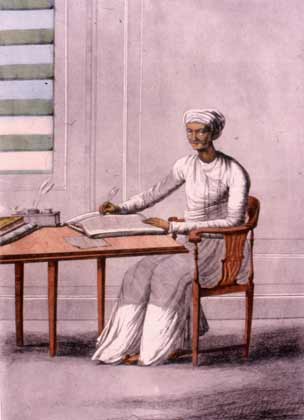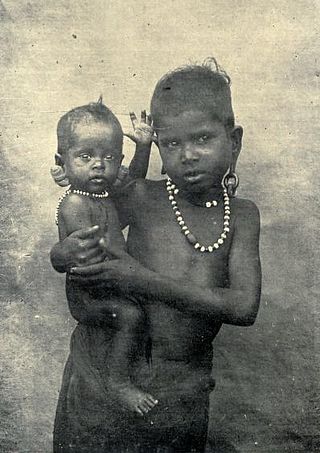Related Research Articles
Varṇa, in the context of Hinduism, refers to a social class within a hierarchical traditional Hindu society. The ideology is epitomized in texts like Manusmriti, which describes and ranks four varnas, and prescribes their occupations, requirements and duties, or Dharma.

Khatri is a caste originating from the Punjab region of South Asia that is predominantly found in India, but also in Pakistan and Afghanistan. In the Indian subcontinent, they were mostly engaged in mercantilistic professions such as banking and trade. They were the dominant commercial and financial administration class of late-medieval India. Some in Punjab often belonged to hereditary agriculturalist land-holding lineages, while others were engaged in artisanal occupations and some were scribes learned in Sanskrit or Persian.

Kayastha or Kayasth denotes a cluster of disparate Indian communities broadly categorised by the regions of the Indian subcontinent in which they were traditionally located—the Chitraguptavanshi Kayasthas of North India, the Chandraseniya Kayastha Prabhus of Maharashtra, the Bengali Kayasthas of Bengal and Karanas of Odisha. All of them were traditionally considered "writing castes", who had historically served the ruling powers as administrators, ministers and record-keepers.

Kurmi is traditionally a non-elite tiller caste in the lower Gangetic plain of India, especially southern regions of Awadh, eastern Uttar Pradesh and parts of Bihar. The Kurmis came to be known for their exceptional work ethic, superior tillage and manuring, and gender-neutral culture, bringing praise from Mughal and British administrators alike.
Deshastha Brahmin is a Hindu Brahmin subcaste mainly from the Indian state of Maharashtra and North Karnataka. Other than these states, according to authors K. S. Singh, Gregory Naik and Pran Nath Chopra, Deshastha Brahmins are also concentrated in the states of Telangana (which was earlier part of Hyderabad State and Berar Division), Andhra Pradesh and Madhya Pradesh (Which was earlier part of Central Provinces and Berar) Historian Pran Nath Chopra and journalist Pritish Nandy say, "Most of the well-known saints from Maharashtra, Karnataka and Andhra Pradesh were Deshastha Brahmins". The mother tongue of Deshastha Brahmins is either Marathi, Kannada or Telugu.
Chitrapur Saraswats are a small Konkani-speaking community of Hindu Brahmins in India. They are traditionally found along the Kanara coast and call themselves Bhanaps in the Konkani language.
Karhaḍe Brahmins are a Hindu Brahmin sub-caste mainly from the Indian state of Maharashtra, but are also distributed in states of Goa, Karnataka and Madhya Pradesh.
Telugu Brahmins are Telugu-speaking Brahmin communities native to the Indian states of Andhra Pradesh and Telangana. They fall under the Pancha Dravida Brahmin classification of the Brahmin community in India. Telugu Brahmins are further divided into sections like Vaidiki, Niyogi, Deshastha, Dravida, Golkonda Vyapari among others.

Bengali Brahmins are the community of Hindu Brahmins, who traditionally reside in the Bengal region of the Indian subcontinent, currently comprising the Indian state of West Bengal and the country of Bangladesh.
Chandraseniya Kayastha Prabhu (CKP) or historically and commonly known as Chandraseniya Prabhu or just Prabhu is an ethnic group mainly found in Gujarat and Maharashtra. Historically, they made equally good warriors, statesmen as well as writers. They held the posts such as Deshpande and Gadkari according to the historian, B.R. Sunthankar, produced some of the best warriors in Maharashtrian history.

The caste system in India is the paradigmatic ethnographic instance of social classification based on castes. It has its origins in ancient India, and was transformed by various ruling elites in medieval, early-modern, and modern India, especially in the aftermath of the collapse of the Mughal Empire and the establishment of the British Raj. It is today the basis of affirmative action programmes in India as enforced through its constitution. The caste system consists of two different concepts, varna and jati, which may be regarded as different levels of analysis of this system.
Banerjee, also known as Bandyopadhyay, is a Bengali Kulin Brahmin surname originating from the Bengal region of the Indian subcontinent. The surname belongs to the Rarhi clan of Bengali Brahmin caste.
Bhumihar, also locally called Bhuinhar and Babhan, is a Hindu caste mainly found in Bihar, the Purvanchal region of Uttar Pradesh, Jharkhand, the Bundelkhand region of Madhya Pradesh, and Nepal.

Kallar is one of the three related castes of southern India which constitute the Mukkulathor confederacy. The Kallar, along with the Maravar and Agamudayar, constitute a united social caste on the basis of parallel professions, though their locations and heritages are wholly separate from one another.
The Ahir is a Hindu caste of Northern India.The Ahir clans are spread almost all over country. There are three main divisions among Ahirs: Yaduvanshi, Nandvanshi and Gwalvanshi. All Ahirs, no matter where they reside, were originally of the same ethnic stock; and it is probable that they were originally a nomad tribe of pastorals, probably Scythian, who entered India, via Persia and Baluchistan.
Baidya or Vaidya is a Hindu community located in Bengal. A caste (jāti) of Ayurvedic physicians, the Baidyas have long had pre-eminence in society alongside Brahmins and Kayasthas. In the colonial era, the Bhadraloks were drawn primarily, but not exclusively, from these three upper castes, who continue to maintain a collective hegemony in West Bengal.

Bengali Kayastha, is a Bengali Hindu caste originated from the Bengal region of Indian subcontinent, and is one of the main subgroups of the Kayastha community. The historical caste occupation of Kayasthas throughout India has been that of scribes, administrators, ministers and record-keepers; the Kayasthas in Bengal, along with Brahmins and Baidyas, are regarded among the three traditional higher castes that comprise the "upper layer of Hindu society." During the British Raj, the Bhadraloks of Bengal were drawn primarily, but not exclusively, from these three castes, who continue to maintain a collective hegemony in West Bengal.
Bhaduri, is a native Bengali surname found among Bengali Brahmins of India and Bangladesh. The surname belongs to the Barendra class of Bengali Brahmin caste.
Ghosal or Ghoshal is a surname found among the Bengali Brahmins, a Brahmin caste associated with the Bengal region of the Indian subcontinent. The Ghoshals belong to the Rarhi class of Bengali Brahmins.
Balaram Hari (Bengali: বলরাম হাড়ি; 1825 –1890; was a prominent Bengali saint, religious leader, songwriter, social reformer in Bengal of British India. He established the Balarami sect, also known as Balaram Bhaja or Balahadi sect. The ideal of the Balarami is to lead a pure and simple life, above greed and sensuality. They consider praying to be their fundamental duty. They consider stealing and lying great sins. According to them, the universe is the body of God. Hindu disciples call their deity Hadi-Rama, while Muslim disciples use the term Hadi-Allah. Balahadis are still to be found at some places like Meherpur, Nishchintapur in Nadia, Daikiari in Purulia, Shalunigram in Bankura etc.
References
- ↑ Pinch, William R. (1996). Peasants and monks in British India . University of California Press. p. 179. ISBN 978-0-520-20061-6.
- 1 2 3 Bayly, Susan (2001). Caste, Society and Politics in India from the Eighteenth Century to the Modern Age. Cambridge University Press. pp. 163–165. ISBN 978-0-521-79842-6.
- ↑ Bhattacharya, Jogendra Nath (1896). Hindu Castes and Sects: An Exposition of the Origin of the Hindu Caste System and the Bearing of the Sects toward Each Other and toward Other Religious Systems. Calcutta: Thacker, Spink. p. iii.
- ↑ Bayly, Susan (2001). Caste, Society and Politics in India from the Eighteenth Century to the Modern Age. Cambridge University Press. p. 165. ISBN 978-0-521-79842-6.
- ↑ Keane, David (2007). Caste-based discrimination in international human rights law. Ashgate Publishing. p. 51. ISBN 978-0-7546-7172-5.